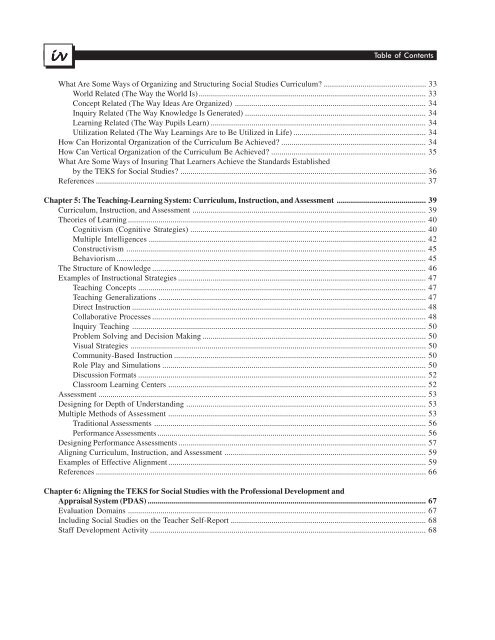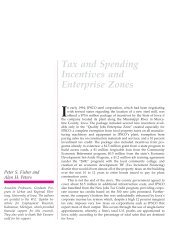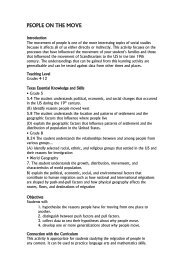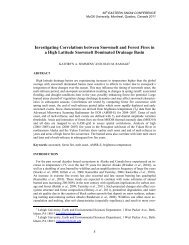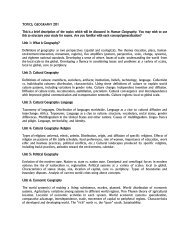Texas Social Studies Framework - Department of Geography ...
Texas Social Studies Framework - Department of Geography ...
Texas Social Studies Framework - Department of Geography ...
You also want an ePaper? Increase the reach of your titles
YUMPU automatically turns print PDFs into web optimized ePapers that Google loves.
iv<br />
iv<br />
Table <strong>of</strong> Contents<br />
What Are Some Ways <strong>of</strong> Organizing and Structuring <strong>Social</strong> <strong>Studies</strong> Curriculum? .................................................. 33<br />
World Related (The Way the World Is)................................................................................................................ 33<br />
Concept Related (The Way Ideas Are Organized) .............................................................................................. 34<br />
Inquiry Related (The Way Knowledge Is Generated) ......................................................................................... 34<br />
Learning Related (The Way Pupils Learn) .......................................................................................................... 34<br />
Utilization Related (The Way Learnings Are to Be Utilized in Life) ................................................................. 34<br />
How Can Horizontal Organization <strong>of</strong> the Curriculum Be Achieved? ....................................................................... 34<br />
How Can Vertical Organization <strong>of</strong> the Curriculum Be Achieved? ............................................................................ 35<br />
What Are Some Ways <strong>of</strong> Insuring That Learners Achieve the Standards Established<br />
by the TEKS for <strong>Social</strong> <strong>Studies</strong>? ......................................................................................................................... 36<br />
References ................................................................................................................................................................... 37<br />
Chapter 5: The Teaching-Learning System: Curriculum, Instruction, and Assessment ............................................ 39<br />
Curriculum, Instruction, and Assessment ................................................................................................................... 39<br />
Theories <strong>of</strong> Learning ................................................................................................................................................... 40<br />
Cognitivism (Cognitive Strategies) .................................................................................................................... 40<br />
Multiple Intelligences ......................................................................................................................................... 42<br />
Constructivism .................................................................................................................................................... 45<br />
Behaviorism ......................................................................................................................................................... 45<br />
The Structure <strong>of</strong> Knowledge ....................................................................................................................................... 46<br />
Examples <strong>of</strong> Instructional Strategies .......................................................................................................................... 47<br />
Teaching Concepts .............................................................................................................................................. 47<br />
Teaching Generalizations .................................................................................................................................... 47<br />
Direct Instruction ................................................................................................................................................. 48<br />
Collaborative Processes ....................................................................................................................................... 48<br />
Inquiry Teaching ................................................................................................................................................. 50<br />
Problem Solving and Decision Making .............................................................................................................. 50<br />
Visual Strategies .................................................................................................................................................. 50<br />
Community-Based Instruction ............................................................................................................................ 50<br />
Role Play and Simulations .................................................................................................................................. 50<br />
Discussion Formats .............................................................................................................................................. 52<br />
Classroom Learning Centers ............................................................................................................................... 52<br />
Assessment .................................................................................................................................................................. 53<br />
Designing for Depth <strong>of</strong> Understanding ...................................................................................................................... 53<br />
Multiple Methods <strong>of</strong> Assessment ............................................................................................................................... 53<br />
Traditional Assessments ...................................................................................................................................... 56<br />
Performance Assessments ..................................................................................................................................... 56<br />
Designing Performance Assessments .......................................................................................................................... 57<br />
Aligning Curriculum, Instruction, and Assessment ................................................................................................... 59<br />
Examples <strong>of</strong> Effective Alignment ............................................................................................................................... 59<br />
References ................................................................................................................................................................... 66<br />
Chapter 6: Aligning the TEKS for <strong>Social</strong> <strong>Studies</strong> with the Pr<strong>of</strong>essional Development and<br />
Appraisal System (PDAS) .......................................................................................................................................... 67<br />
Evaluation Domains ................................................................................................................................................... 67<br />
Including <strong>Social</strong> <strong>Studies</strong> on the Teacher Self-Report ................................................................................................ 68<br />
Staff Development Activity ........................................................................................................................................ 68


